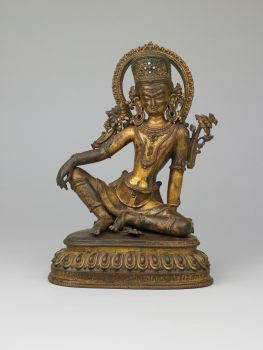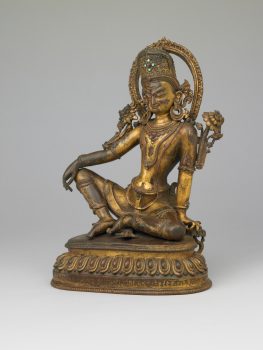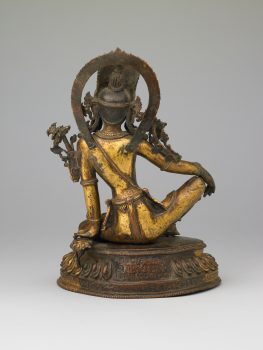Nepal
Dated by inscription,1463



Nepal
Dated by inscription,1463



Indra, the Hindu god of gods, is highly revered in Nepal. Each of his hands held the stalk of a lotus, the one to the side of his left shoulder bearing his attribute, the vajra. Even without this identifying attribute, Indra can easily be recognized on the basis of the horizontal eye on his forehead and the broad crown.This sculpture features a number of elements characteristic for Nepalese sculpture, such as the gentle smile, hawk-like nose, and the dress with a scarf crossing the thighs. The reddish tone of the metal where the gilding has worn away indicates a high copper content, which is also typical of Nepalese sculpture. Owing to the dated inscription written at the bottom of the base, this image is an important historical document, providing a dated anchor for constructing a chronology of Nepalese art.
A virtuous feeling and deep respect toward an authentic teaching, teacher, or path. Buddhists believe that expansive study, analysis, and meditation are essential steps for cultivating a healthy and enduring devotion.
Buddhist practitioners in some traditions believe that cutting through ordinary perceptions that keep us in the endless cycle of death and rebirth, known as samsara, can create a powerful and enhanced divine identity that leads to enlightenment.
Hindu gods (deva) are thought to be manifestations of the absolute, or Brahman. The goddesses (devi) are considered manifestations of the Great Mother Goddess (Mahadevi), who is seen as the counterpart to Brahman.
The Himalayan kingdoms of the Kathmandu Valley were significant centers of Buddhist culture. Nepalese kings, Buddhist institutions, and ordinary people patronized the vibrant art guilds. The artistic traditions of the regions are well-known in Tibetan areas and beyond, and Newar artists have always been in high demand throughout Tibetan regions and Inner Asia.
Get the latest news and stories from the Rubin, plus occasional information on how to support our work.